Your temporary/preparatory prosthesis was made especially for you from a cast impression of your residual limb. This prosthesis is designed to be worn while your residual limb continues to heal and mature in size and shape. During this time it is expected that adjustments will be required to maintain the fit and accommodate these changes.
There are three distinct mechanisms in the maturing process:
- Post Surgical Edema (swelling): This is a result of the surgical process. It is normal and generally resolves in a few weeks with the help of compressive dressings like ace bandages and stump shrinker socks.
- Muscle Atrophy (thinning musculature): The muscles located in the residual limb generally operate the next joint down. Muscles in the thigh operate the knee and muscles in the leg operate the ankle. As the normal functioning of these muscles ceases , they become smaller from lack of use. This is normal and advantage is that as the muscles shrink, the skeletal parts of the stump have better control of the prosthetic socket. The majority of these changes generally occur within the first few months after amputation.
- Long Term Effects of Socket Pressure: These changes occur over a long period of time and are the body’s natural response to long-term pressure. Remember your body never stops changing.
General Care
- The prosthetic socket environment is warm, dark, and humid due to our weather conditions, this is favourable for bacterial growth.
- It is imperative that the skin and socks be clean and washed daily..
- The socket liner (insert) should also be washed regularly. Soap and water with a sponge or a soft cloth works well, water will not harm the liner. Soap and detergents are fine for cleaning. Be sure to use plenty of water to rinse out the residue. Dry with a towel.
- The plastic socket should also be cleaned periodically.
- Be aware of any changes such as noises or loosening. If this occurs, contact us as soon as possible.
Suspension Sleeve
Below Knee Prosthetic Suspension Sleeve
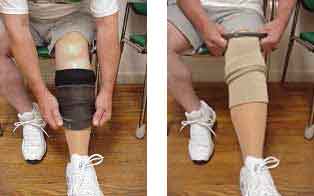
- The suspension sleeve is generally very effective to “suspend” or hold the prosthesis on. It can be used as a primary or auxiliary suspension.
- Textile type sleeves work due to their friction or “grab” to the thigh and top of the prosthesis. Gel type sleeves (silicone, urethane or others) work by also creating an airtight seal between the thigh skin and the top of the prosthesis.
- All sleeves have a limited life span and will eventually wear out or tear, requiring replacement.
- An under layer of cloth may be attached over the top of the prosthesis to protect the sleeve from the socket trimlines.
- Most sleeves work best when pulled as high as possible on the thigh. This provides the maximum surface area for the sleeve to grab and spreads the load over a greater area.
- Skin irritations, usually in the form of a rash, can occur when the sleeve is not regularly washed. Cloth sleeves can generally be hand washed or put in a washing machine. Gel sleeves must be hand washed.
- A ring or line of redness can occur on the thigh near the top of the sleeve if it is too tight or the skin is very soft. In this case a short tube of cloth or nylon can be placed under the top inch or so of the sleeve to reduce the shear forces, which cause this.
- All sleeves will restrict knee bending to some extent. This usually improves in time as the sleeve breaks in and the amputee gets accustomed to wearing it.
- Care should be taken to avoid kneeling on the sleeve or other activities that would damage the sleeve and cause its premature failure.
Donning the Sleeve
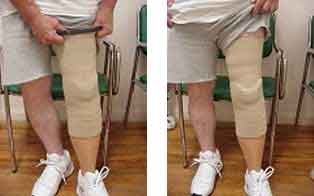
To don the suspension sleeve begin with it rolled down. Grasp it firmly on both sides and pull it upward. The sleeve will turn right-side-out as it is pulled up over the top of the socket and onto the thigh. A light dusting of non-scented powder may make the sleeve slide more easily.
Standing with weight on the prosthesis will help to pull the sleeve tightly and fully up onto the thigh. It is important to make sure the sleeve has as much contact with the thigh skin as possible to maximize its grip. Stump socks too high under the sleeve may allow it to slip down.
Once the sleeve is in place full Pants or trousers can be pulled up over.
Donning Silicone / Gel Insert – Instructions
Gel inserts are generally worn directly over the skin and must be cleaned thoroughly before and after each use with soap and water. Occasionally use rubbing alcohol / spirit to further disinfect. Any irritant such as hairs, dust, or bacteria will be rubbed into the damp skin as the liner is worn and cause irritation. Petroleum based lubes or barrier creams are helpful to reduce skin tension. Begin donning the liner by turning it inside out completely as shown so it is pointing straight off the bottom of the liner. Poorly aligning the pin may not engage the lock. The pin can be felt through the liner. Be sure not to allow the pin to poke through the gel. Once positioned properly the liner is ROLLED up onto the limb. This is to ensure the gel is not stretched and is applied with even tension on the skin. Keep hands on the leading edge as you roll to avoid wrinkling the insert.
Shuttle Locking Pin
Properly Applying Stump Socks over Shuttle Locking Pins Systems – Instructions
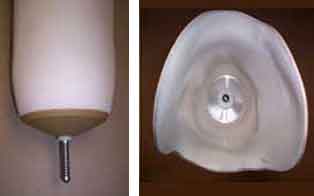
- Adding socks is essential to maintaining a proper fit in your prosthesis.
- Applying socks improperly over a pin can jam the lock and make removing the prosthesis difficult.
- Check regularly that the pin is securely installed.
- It should not be loose or easily removed.
- Visually check that there are no foreign objects in the socket.
- When applying socks make sure the pin is uncovered.
- Just a few threads can jam the pin in the lock.
- Remove any loose threads with scissors.
- If it is difficult to see the pin, reach down and feel the pin to make sure it is exposed properly.
- If you are unable to determine whether the pin is free, seek assistance.
- If properly done, you will hear audible clicks as the pin engages.
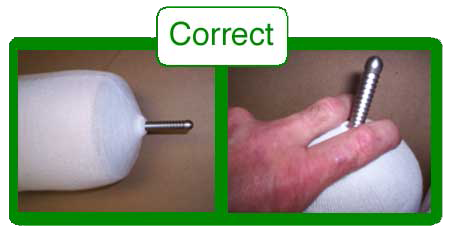
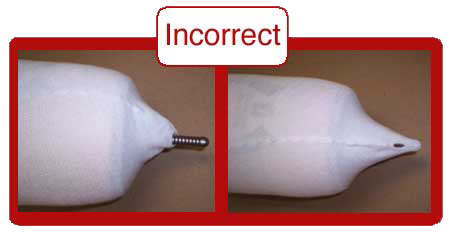
Straighten the knee as you roll past it to avoid uneven top edges. MAKE SURE to keep any socks or sheaths off the pin before sliding into socket.

